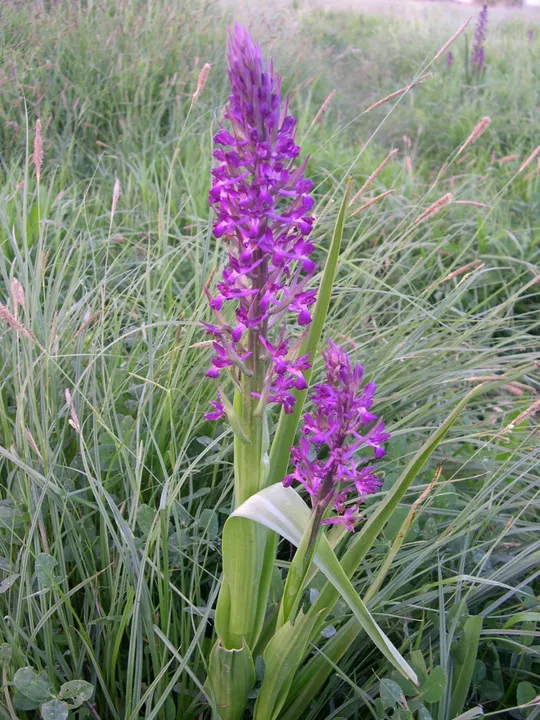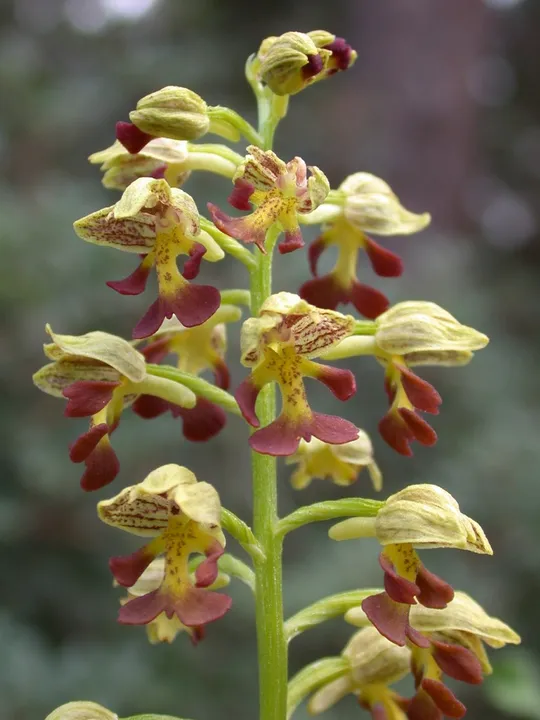Bug Orchid
Orchis coriophora
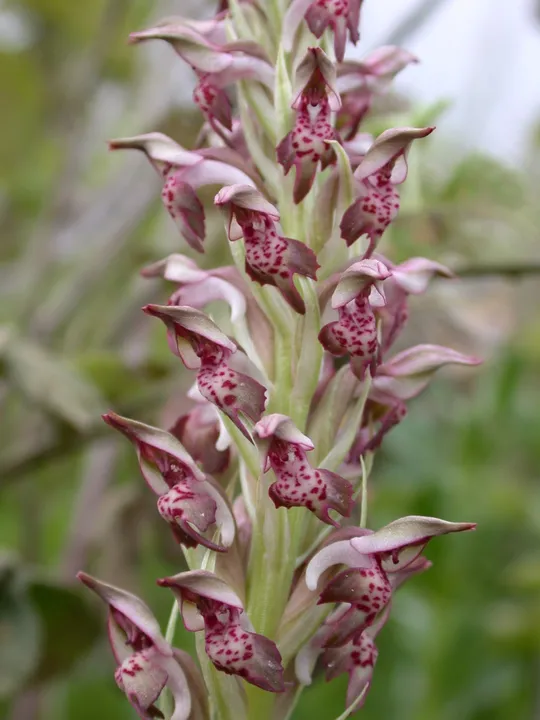
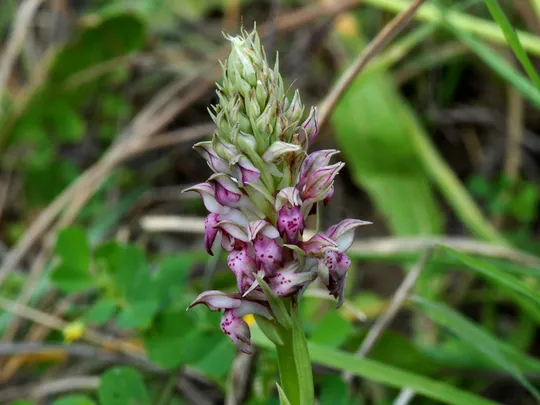
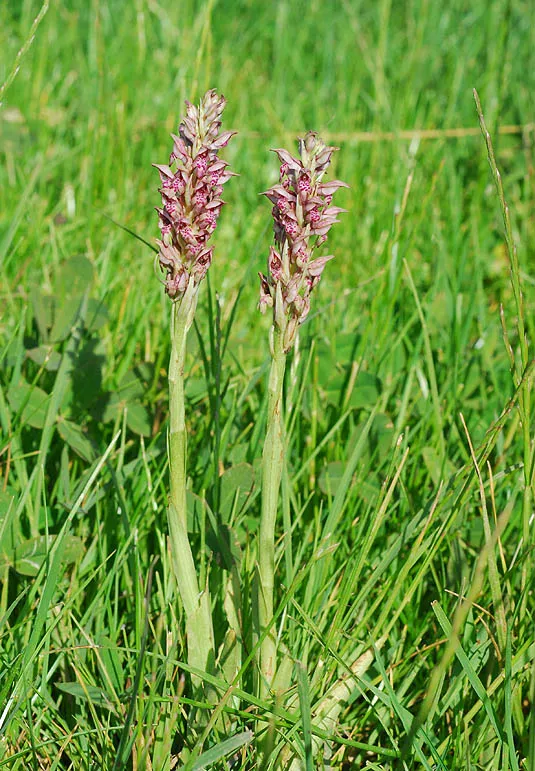
Orchis coriophora now grows in only
two regions in the extreme north of the country: the low Hermon and the northern
Hula Valley. It is found at eight documented sites in Israel, but according to estimates,
there are about 10 sites. Of the documented sites, six of are located in the
lower Hermon in the in the Yafori Valley-Mount Keta-Neve Ativ area. In the Hula
Valley, there is one known site in the Sahlavim Reserve near Hurshat Tal. Recently (2009) another site
was reported (Talia Oron) in the northern Hula Valley in the Snir - Nohela
tributaries area. O.
coriophora once grew
in four additional regions from which it has become extinct: in 1920-1940, it
was collected in the Sharon from the Batih Pond, in the Upper Galilee from
Peki'in, in the Jezreel Valley from Tel Yosef and in Pleshet in Petah Tikva.
Shrubland and herbaceous vegetation on fallow fields,
soils on travertine rock.
Orchis coriophora
has two distinct subspecies that differ in color, morphology and smell as well
as in in their distribution. The typical subspecies, the more northerly one, has
characteristic dark flowers, a broader labellum with shorter lobes and an unpleasant
odor (a smell reminiscent of bugs, hence the scientific name of the species coriophora
– carries the smell of a bug). The southern subspecies, fragrans, has
lighter flowers, an odor reminiscent of vanilla, and is also found in Israel (Kretzschmar
et al., 2007). The boundaries between the two subspecies are not clear, but
they have rarely been observed together throughout their ranges. This seems to
be a case of the speciation of one species into two, each producing a different
odor, attracting different sized pollinators and growing in different climatic
zones, although they are extremely close genetically. Thorough research along
the common border of their ranges will reveal whether there are any transition
forms between them, or whether they are already two separate species.
Following research and molecular analysis, O. coriophora was transferred together with
other Orchis species to the genus Anacamptis (Pridgeon et al.,
1997). As this change was not accepted in all publications it was not
implemented here.
O. coriophora is close to the
O.
santa that also grows in Israel and has
characteristic larger flowers and a long pointed labellum that is not dotted. O. santa is also rare and in decline in Israel, although it is
not endangered on a national scale and more than a hundred of its sites are
known.
·
The number of regions and sites in
which Orchis coriophora
is found is on a pronounced decline due to extinction. Today, except for the site at
the foot of Mount Hermon, there is only one known site in Israel. At this site
(Hurshat Tal) too, the population exhibits a marked decrease from thousands to
hundreds of plants as a result of domination by Rubus sanguineus and Foeniculum
vulgare.
·
Habitat loss and small populations are
probably previous extinction factors that also pose a threat to the present
populations.
·
O. coriophora is protected by
virtue of being part of the family Orchidaceae. It is protected on Mount Keta that
is in the Mount Hermon Reserve and in the Sahlavim Reserve near Hurshat Tal
·
O. coriophora has a broad
global distribution. In the IUCN lists, it is classified as VU in Croatia, EN
in Switzerland and is probably extinct from Estonia.
Orchis coriophora populations in
existing sites should be monitored and efforts made to find it again in regions
from which it was previously known.
Orchis coriophora is a widely
distributed mostly European species, found throughout most of Europe except for
its northern sections. O. coriophora grows around
the Mediterranean Basin – southern Europe, North Africa, Turkey to Israel and
in all the Mediterranean islands. In the east, it grows in the southern
Caucasus, northern Iraq and northern Iran. The typical subspecies coriophora
grows in the northern and eastern area of its range.
The subspecies fragrans grows mainly around the Mediterranean.
Orchis coriophora is an extremely
rare orchid species whose number of regions and sites in Israel has declined sharply
since the 20th century, mainly due to habitat loss. Israel is located at the
southern edge of its global distribution, and is not globally endangered.
Krestzschmar, H. Eccarius, W. & Dietrich, H. 2007. The Orchid Genera: Anacamptis, Orchis, Neotinea. EchinoMedia. 544 pp
Current Occupancy Map
| 1000 squre meter pixel | 5000 squre meter pixel | 10000 squre meter pixel | |
|---|---|---|---|
| number of observations | 0 | 0 | 0 |
| in total pixels | 0 | 0 | 0 |
| Family | orchidaceae |
| Classification | On the endangered species list |
| Ecosystem | Mediterranean |
| Chorotype | Mediterranean – Western Irano –Turanian |
| Conservation Site | Mount Keta, Sahlavim Reserve at Hurshat Tal |
| Rarity |
1
3
6
|
|---|---|
| Vulnerability |
0
3
4
|
| Attractiveness |
0
1
4
|
| Endemism |
0
0
4
|
| Red number |
1
4.2
10
|
| Peripherality | N |
| IUCN category | DD EW EX LC CR EN VU NT |
| Threat Definition according to the red book | Endangered |
 Based on:
Based on:

